Japanese occupation of Hong Kong
Hong Kong Occupied Territory 香港占領地[1] | |||||||||
|---|---|---|---|---|---|---|---|---|---|
| 1941–1945 | |||||||||
| Status | Annexed dependency of Empire of Japan | ||||||||
| Capital | N/A | ||||||||
| Common languages | Cantonese, Japanese, English | ||||||||
| Religion | Shintō a | ||||||||
| Government | Constitutional monarchy | ||||||||
| Emperor of Japan | |||||||||
• 1941–1945 | Hirohito | ||||||||
| Governor of Hong Kong | |||||||||
• 1941–1942 | Takashi Sakai and Masaichi Niimi | ||||||||
• 1942–1944 | Rensuke Isogai | ||||||||
• 1944–1945 | Hisakazu Tanaka | ||||||||
| Historical era | World War II | ||||||||
| 25 December 1941 | |||||||||
| 15 August 1945 | |||||||||
| Population | |||||||||
• 1941 | 1.6 million | ||||||||
• 1945 | 600,000 | ||||||||
| Currency | Japanese military yen | ||||||||
| |||||||||
The Japanese occupation of Hong Kong (香港日治時期) began after the Governor of Hong Kong, Sir Mark Young, surrendered the territory of Hong Kong to Japan on 25 December 1941 after 18 days of fierce fighting by British, Indian and Canadian defenders against overwhelming Japanese Imperial forces.[5][6] The occupation lasted for three years and eight months until Japan surrendered. The length of this period (in Chinese, 三年零八個月) later became a metonym of the occupation.[6]
Background
During Japanese invasion of China
During the Japanese invasion of China in 1937, Hong Kong was not invaded or occupied, being part of the British empire. Nevertheless, its situation was influenced by the war in China due to proximity to the mainland. In early March 1939, during a bombing raid on Shenzhen, a few bombs fell accidentally on Hong Kong, destroying a bridge and a train station.[7]
World War II
In the autumn of 1941, the Third Reich was at its height of power. German forces had overrun much of Western Europe and were racing towards Moscow in the invasion of the Soviet Union. Although still officially neutral, United States was actively supporting Britain, the British Commonwealth and the Soviet Union in their war against Germany, and had imposed a 100% embargo on the sale of oil to Japan after less aggressive forms of economic warfare had failed to bring about changes in Japanese foreign policy in China and French Indo-china (Vietnam). This prompted Japan to launch a sudden attack against the U.S. naval base at Pearl Harbor on 7 December 1941 (Honolulu time), against American military bases in the Philippines, and against strategic targets elsewhere in the Pacific and East Asia.
Battle of Hong Kong
As part of a general Pacific campaign, the Japanese launched an assault on Hong Kong on the morning of 8 December 1941 Hong Kong local time.[8] British, Canadian and Indian forces, supported by the Hong Kong Volunteer Defence Forces attempted to resist the rapidly advancing Japanese but were heavily outnumbered. After racing down the New Territories and Kowloon, Japanese forces crossed Victoria Harbour on 18 December.[9] After fierce fighting continued on Hong Kong Island, the only reservoir was lost. Canadian Winnipeg Grenadiers fought at the crucial Wong Nai Chong Gap that secured the passage between Hong Kong proper and secluded southern sections of the island. Finally defeated, on 25 December 1941, British colonial officials headed by the Governor of Hong Kong Mark Aitchison Young surrendered at the Japanese headquarters.[2] To the local people, the day was known as "Black Christmas".[citation needed]
The capitulation of Hong Kong was signed on the 26th at The Peninsula Hotel.[10] On 20 February 1942 General Rensuke Isogai became the first Japanese governor of Hong Kong.[11] Just before the British surrendered, drunken Japanese soldiers entered St. Stephen's College, which was being used as a hospital.[12] The Japanese then confronted two volunteer doctors and shot both of them when entry was refused.[12] They then burst into the wards and bayoneted all the wounded soldiers who were incapable of hiding in what was known as the St. Stephen's college incident.[12] This ushered an almost four years of brutal Imperial Japanese administration.
Politics
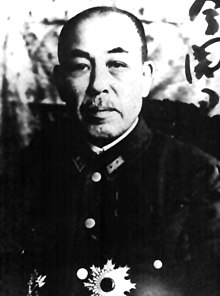
Throughout the Japanese occupation, Hong Kong was ruled as a detained terrain and was subjected to martial law.[13] Headed by General Rensuke Isogai, the Japanese established their administration and commanding post at the Peninsula Hotel in Kowloon. The military government, composed of the departments of politics, civilian, economy, judiciary, and navy, enacted stringent regulations and established executive bureaus to have power over all residents of Hong Kong. On top of Governor Mark Young, 7,000 British soldiers and civilians were kept in prisoner-of-war or internment camps, such as Sham Shui Po Prisoner Camp and Stanley Internment Camp.[14] Famine, malnourishment and sickness were pervasive. Severe cases of malnutrition among inmates occurred in the Stanley Internment Camp in 1945. Moreover, the Japanese military government blockaded Victoria Harbour and controlled warehouses.
Early in January 1942, former members of the Hong Kong Police including the Indians and Chinese were recruited into a reformed police called the Kempeitai with new uniforms.[15] The police routinely performed executions at King's Park in Kowloon by using Chinese for beheading, shooting and bayonet practice.[15] The Japanese gendarmerie took over all police stations and organised the Police in five divisions, namely East Hong Kong, West Hong Kong, Kowloon, New Territories and Water Police. The headquarters was situated in the former Supreme Court Building.[16] Police in Hong Kong were under the organisation and control of the Japanese government. Japanese experts and administrators were chiefly employed in the Governor's Office and its various bureaus. Two councils of Chinese and Eurasian leaders were setup to manage the Chinese population.[15]
Economy
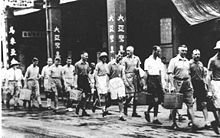
Economically, all trading activities were sternly guarded, and the majority of the factories were taken over by the Japanese. Having deprived the vendors and banks of their possessions, the Hong Kong Dollar was outlawed and replaced by the Japanese Military Yen.[17] The exchange rate was fixed at 2 Hong Kong dollars to one military yen in January 1942.[18] Later, the yen was re-valued at 4 Hong Kong dollars to a yen in July 1942, which meant local people could exchange fewer military notes than before.[18] While the citizens of Hong Kong became poor in forced exchanges, the Japanese government sold the Hong Kong Dollar to help finance their war-time economy. Later, the yen was made the sole legal tender for official purposes in June 1943. Prices of commodities for sale had to be marked in yen. Hyper-inflation then disrupted the economy, directly affecting Hong Kong citizens.[17] Enormous devaluation of the Japanese Military Yen after the war made it almost worthless.[10]
Public transportation and utilities unavoidably failed, owing to the shortage of fuel and through the augmentation of American air raids on Hong Kong. Tens of thousands of people became homeless and helpless, and many of them were employed in shipbuilding and construction. In the agricultural field, the Japanese took over the race track at Fanling and the air strip at Kam Tin for their rice-growing experiments.[5][19]
With the intention of boosting the Japanese influence on Hong Kong, two Japanese banks, the Yokohama Specie Bank and the Bank of Taiwan, were re-opened.[5] These two banks replaced the HongKong and Shanghai Bank and two other British banks responsible for issuing the banknotes.[5] They then liquidated various Allied banks.[5] British, American and Dutch bankers were forced to live in a small hotel, while some bankers who were viewed as the enemy of the Japanese were executed. In May 1942, Japanese companies were encouraged to be set up. A Hong Kong trade syndicate consisting of Japanese firms was set up in October 1942 to manipulate overseas trade.[19]
Community life, social services and public hygiene
Life in fear

The Japanese enforced a repatriation policy throughout the period of occupation because of the scarcity of food and the possible counter-attack of the Allies. As a result, the unemployed were deported to the Mainland, and the population of Hong Kong had dwindled from 1.6 million in 1941 to 600,000 in 1945.[20] Furthermore, the Japanese reconstructed both government and private facilities for the sake of their own interests and developments. In order to expand the Kai Tak Airport, for example, the Japanese demolished the Sung Wong Toi Monument in today’s Kowloon City. Buildings of some prestigious secondary schools such as Jesuits' Wah Yan College Hong Kong, Diocesan Boys' School, the Central British School, the St. Paul's Girls' College of the Anglican church and de La Salle brothers' La Salle College were commandeered as military hospitals by the Japanese. Diocesan Boys' School was even rumoured to be the execution place of the Japanese.
Life was hard for people under Japanese rule. As there was inadequate food supply, the Japanese rationed necessities such as rice, oil, flour, salt and sugar. Each family was given a rationing licence, and every person could only buy 6.4 taels (240 g (8.5 oz)), of rice per day.[1] Most people did not have enough food to eat, and many died of starvation. The rationing system was cancelled in 1944. An estimate was put forward by one Chinese physician who practiced in HK between 1941 and 1942 that at least 10,000 girls and women were raped in the month following Japanese victory.[11]
Charity and social services
During the occupation, hospitals available to the masses were limited. The Kowloon Hospital and Queen Mary Hospital were occupied by the Japanese army.[21] Despite the lack of medicine and funds, the Tung Wah and Kwong Wah Hospital continued their social services but in a limited scale. These included provision of food, medicine, clothing, and burial services. Although funds were provided, they still had great financial difficulties. Failure to collect rents and the high reparation costs forced them to promote fundraising activities like musical performances and dramas.
Tung Wah hospital and the charitable organisation Po Leung Kuk continued to provide charity relief. Substantial donations were given by members of Chinese elite.[22] Po Leung Kuk also took in orphans. However faced with financial problems during the occupation, their bank deposits could not be withdrawn under Japanese control. Their services could only be continued through donations by Aw Boon Haw, a long-term financier of Po Leung Kuk.
Health and public hygiene
There were very few public hospitals during the Japanese occupation as many of them were forced to be converted to military hospitals. With the inadequate supply of resources, Tung Wah Hospital and Kwong Wah Hospital still continuously offered limited social services to needy persons. In June 1943 the management of water, gas and electricity was transferred into private Japanese hands.[5]
Education, press and political propaganda
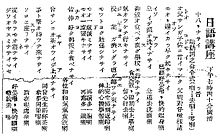

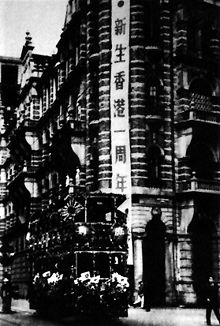
Through schooling, mass media and other means of propaganda, the Japanese tried to control the mindsets of Hong Kong people so as to build up a stronger administration regime. Japanisation was a common means for restricting people's thinking, and it prevailed in different aspects of daily life.
Japanese education
It was the Japanese conviction that education was an imperative means in infusing Japanese influence. Teaching of the Japanese language was obligatory, and students who received bad results in Japanese exams risked corporal punishment. English could not be taught nor was it tolerated outside the classroom.[23] Some private Japanese language schools were established to promote oral Japanese. The Military Administration ran the Teachers' Training Course, and those teachers who failed a Japanese bench-mark test would need to take a three-month training course. The Japanese authorities tried to introduce Japanese traditions and customs to Hong Kong students through the Japanese lesson at school. Famous historical stories such as Mori Motonari(毛利元就)'s “Sanbon no ya(Three Arrows)” and Xufu(徐福)’s voyage to Japan were introduced in Japanese language textbook.[24] The primary aims of this Japanisation of the education system were mainly to facilitate the Japanese control over the local people and to establish the Greater East Asia Co-prosperity Sphere. Therefore, what it was trying to create was a rush to learn Japanese. On the other hand, by 1943, only one formal language school, the Bougok School (寳覺學校), had provided Cantonese language course to Japanese people in Hong Kong. According to the instructor of Bougok School, “teaching Cantonese is difficult because there is no system and set pattern in Cantonese grammar; and you have to change the pronunciation as the occasion demands” and “it would be easier for a Cantonese people to learn Japanese than a Japanese people to learn Cantonese.”[25]
Propaganda
The Japanese promoted a bilingual system of English with Japanese as a communication link between the locals and the occupying forces. English shop signs and advertisements were taken away, and in April 1942, streets and buildings in Central were renamed in Japanese. For example, Queen's Road Central became Meiji-dori and Des Voeux Road became Shōwa-dori.[5][26] Similarly, the Gloucester Hotel became the Matsubara.[27] The Peninsula Hotel, the Matsumoto;[28] Lane Crawford, Matsuzakaya.[29] The Queen's Theatre was renamed first the Nakajima-dori, then the Meiji.[29] Their propaganda also pointed to the pre-eminence of the Japanese way of life, of Japanese spiritual values and the ills of western materialism.
The commemoration of Japanese festivals, state occasions, victories and anniversaries also strengthened the Japanese influence over Hong Kong. For instance, there was Yasukuri or Shrine Festival honouring the dead. There was also a Japanese Empire Day on 11 February 1943 centred around the worship of the Emperor Jimmu.[19]
Press and entertainment
The Hong Kong News, a pre-war Japanese-owned English newspaper, was revived on January 1942 during the Japanese occupation.[30] The editor, E.G. Ogura, was Japanese and the staff members were mainly Chinese and Portuguese who previously worked for the South China Morning Post.[23][30] It became the mouthpiece of the Japanese propaganda.[30] Ten local Chinese newspapers had been reduced to five in May. These newspapers were under press censorship. Radio sets were used for Japanese propaganda. Amusements still existed, though only for those who could afford them. The cinemas only screened Japanese films, such as The Battle of Hong Kong, the only film made in Hong Kong during the Japanese occupation.[31] Directed by Tanaka Shigeo and produced by the Dai Nippon Film Company, the film featured an all-Japanese cast but a few Hong Kong film personalities were also involved. This film appeared on the first anniversary of the attack.
Anti-Japanese resistance
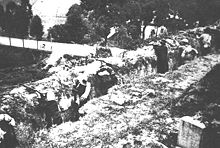
East River Column
Originally formed by Zeng Sheng (曾生) in Guangdong in 1939, this group was mostly comprised peasants, students, and seamen.[2] When the war reached Hong Kong in 1941, the guerilla force grew from 200 to more than 6,000 soldiers.[2] In January 1942, the Guangdong people's anti-Japanese east river guerrillas (廣東人民抗日游擊隊東江縱隊) was established to reinforce anti-Japanese forces in Dongjiang and Zhujiang Pearl River deltas.[32] The guerillas' most significant contribution to the Allies, in particular, was their rescue of twenty American pilots who parachuted into Kowloon when their planes were shot down by the Japanese.[2] In the wake of the British retreat, the guerillas picked up abandoned weapons and established bases in the New Territories and Kowloon.[2] Applying conventional tactics of guerilla warfare, they killed Chinese traitors and collaborators.[2] They protected traders in Kowloon and Guangzhou, attacked the police station at Tai Po, and bombed Kai Tak Airport.[2] During the Japanese occupation the only fortified resistance was mounted by the East river guerillas.[2]
Hong Kong Kowloon brigade
In January 1942 the HK-Kowloon brigade (港九大隊) was established from the Guangdong People's anti-Japanese Guerilla force.[33] In February 1942 with local residents Cai Guo-liang (蔡國梁) as commander and Chen Da-ming (陳達明) as political commissar, they were armed with 30 machine guns and several hundred rifles left by defeated British forces.[9] They numbered about 400 between 1942 and 1945 and operated in Sai Kung.[9] Additionally, the guerillas were noteworthy in rescuing prisoners-of-war, notably Sir Lindsay, Sir Douglas Clague, Professor Gordan King, and David Bosanquet.[2] In December 1943 the Guangdong force reformed the East river guerillas, absorbing the HK-Kowloon brigade into the larger unit.[33]
British Army Aid Group
The British Army Aid Group was formed in 1942 at the suggestion of Colonel Lindsay Ride.[9] The group rescued allied POWs including airmen shot down and workers trapped in occupied HK.[9] It also developed a role in intelligence gathering.[9] In the process, the Group provided protection to the Dongjiang River which was a source for domestic water in Hong Kong. This was the first organisation in which Britons, Chinese and other nationalities served with no racial divide. Francis Lee Yiu-pui and Paul Tsui Ka-cheung were commissioned as officers.[9]
End of Japanese occupation


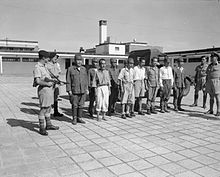
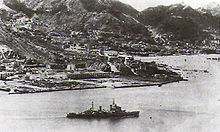
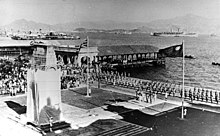
Japanese surrender
The Japanese Occupation of Hong Kong ended in 1945.[6] The United States dropped an atomic bomb on Hiroshima on 6 August 1945.[34] Another one was dropped on Nagasaki three days later; at the same day USSR began Manchurian Strategic Offensive Operation, which crippled the last grand Japanese army in China.[34] Japan finally surrendered on 15 August 1945.[35] The British control over Hong Kong thus was restored.
The Sino-Japanese War "Victory Anniversary Day" (the Saturday preceding the last Monday in August) and "Liberation Day", (the last Monday in August (重光紀念日)) became public holidays. After the transfer of sovereignty of Hong Kong in 1997 Labour Day (5 May) and PRC National Day (1 Oct.) replaced them as official bank holidays.
General Takashi Sakai, who led the invasion of Hong Kong and subsequently served as governor for some time, was tried as a war criminal and executed on the afternoon of 30 September 1946.[36]
Political stage of Hong Kong
The surrender of Japan in 1945 brought with it a new question: who, now, should rule Hong Kong? The Kuomintang's Chiang Kai-shek assumed he would resume the role of controlling the whole of China.[13] Several years earlier, U.S. President Franklin Roosevelt insisted that colonialism would have to end, and promised Soong May-ling that Hong Kong would be restored to Chinese control.[37] But the British moved quickly to regain control of Hong Kong. As soon as he heard word of the Japanese surrender, Franklin Gimson, Hong Kong's colonial secretary, left his prison camp and declared himself the territory's acting governor.[2] A government office was set up in Victoria on 1 September 1945.[13] British Rear Admiral Sir Cecil Halliday Jepson Harcourt sailed into HK on board the cruiser HMS Swiftsure to re-establish British government's control over the colony.[13] He then formally accepted the Japanese surrender on 16 September 1945.[13]
Hong Kong's post-war recovery was astonishingly swift.[15] By November 1945, the economy had recovered so well that government controls were lifted and free markets restored. The population returned to around one million by early 1946 due to immigration from China.[15] Colonial taboos also broke down in the post-war years as European colonial powers realised that they could not administer its colonies like it did before the war. Chinese people were no longer restricted from certain beaches, or from owning assets on Victoria Peak.
See also
- History of Hong Kong
- Battle of Hong Kong
- Sino-Japanese War
- World War II
- Japanese Military Yen
- Japanese occupation of Singapore
- Comfort women
Notes
- ^ a b Fung, Chi Ming. [2005] (2005). Reluctant heroes: rickshaw pullers in Hong Kong and Canton, 1874-1954. Hong Kong University Press. ISBN 9622097340, 9789622097346. p.130, 135.
- ^ a b c d e f g h i j k l Courtauld, Caroline. Holdsworth, May. [1997] (1997). The Hong Kong Story. Oxford university press. ISBN 0195903536. p. 54 - 58.
- ^ Stanford, David. [2006] (2006). Roses in December. Lulu press. ISBN 1847539661.
- ^ Chan, Shun-hing. Leung, Beatrice. [2003] (2003). Changing Church and State Relations in Hong Kong, 1950-2000. Hong Kong: HK university press. Page 24. ISBN 962-2096123.
- ^ a b c d e f g Snow, Philip. [2004] (2004). The fall of Hong Kong: Britain, China and the Japanese occupation. Yale University Press. ISBN 0300103735, 9780300103731. Cite error: The named reference "snow" was defined multiple times with different content (see the help page).
- ^ a b c Mark, Chi-Kwan. [2004] (2004). Hong Kong and the Cold War: Anglo-American relations 1949-1957. Oxford University Press publishing. ISBN 0199273707, 9780199273706. p 14.
- ^ "War in China" Time, 6 March 1939
- ^ Rafferty, Kevin. [1990] (1990). City on the rocks: Hong Kong's uncertain future. Viking publishing. ISBN 0670802050, 9780670802050.
- ^ a b c d e f g Tsang, Steve. [2007] (2007). A Modern History of Hong Kong. I.B.Tauris publishing. ISBN 1845114191, 9781845114190. p 122, 129.
- ^ a b Bard, Solomon Bard. [2009] (2009). Light and Shade: Sketches from an Uncommon Life. Hong Kong University Press. ISBN 9622099491, 9789622099494. p 101, 103.
- ^ a b Roland, Charles G. [2001] (2001). Long night's journey into day: prisoners of war in Hong Kong and Japan, 1941-1945. Wilfrid Laurier Univ. Press. ISBN 0889203628, 9780889203624. p 40, 49.
- ^ a b c Lim, Patricia. [2002] (2002). Discovering Hong Hong's Cultural Heritage. Central, Hong Kong: Oxford University Press. ISBN Volume One 0-19-592723-0. p 73.
- ^ a b c d e Dillon, Mike. [2008] (2008). Contemporary China: An Introduction. ISBN 0415343194, 9780415343190. p 184.
- ^ Jones, Carol A. G. Vagg, Jon. [2007] (2007). Criminal justice in Hong Kong. Routledge-Cavendish. ISBN 9781845680381. p 175.
- ^ a b c d e Carroll, John Mark. [2007] (2007). A concise history of Hong Kong. ISBN 0742534227, 9780742534223. p 123-125, p 129.
- ^ Legislative Council Secretariat: Information note IN26/02-03: The Legislative Council Building
- ^ a b Tse, Helen. [2008] (2008). Sweet Mandarin: The Courageous True Story of Three Generations of Chinese Women and Their Journey from East to West. Macmillan publishing. ISBN 0312379366, 9780312379360. p 90.
- ^ a b Emerson, Geoffrey Charles. [2009] (2009). Hong Kong Internment, 1942-1945: Life in the Japanese Civilian Camp at Stanley Royal Asiatic Society Hong Kong studies series. HKU Press. ISBN 9622098800, 9789622098800. p 83.
- ^ a b c Endacott, G. B. Birch, Alan. [1978] (1978). Hong Kong eclipse. Oxford University Press. ISBN 0195803744, 9780195803747.
- ^ New York Times. "NY Times." Thousands March in Anti-Japan Protest in Hong Kong by Keith Bradsher. Retrieved on 11 April 2006.
- ^ Starling, Arthur E. Hong Kong Museum of Medical Sciences Society (2006). Plague, SARS and the story of medicine in Hong Kong. Hong Kong University Press, 2006. ISBN 9622098053, 9789622098053. p 112, 302.
- ^ Faure, David Faure. [1997] (1997). Society, a Documentary history of Hong Kong. Hong Kong University Press. ISBN 9622093930, 9789622093935. p. 209.
- ^ a b Sweeting, Anthony. [2004] (2004). Education in Hong Kong, 1941 to 2001: visions and revisions. Hong Kong University Press publishing. ISBN 9622096751, 9789622096752. p 88, 134.
- ^ Higuchi, Kenichiro; Kwong, Yan Kit. [2009]."Inflow of Japanese language into Hong Kong during the Japanese occupation period", Journal of Sugiyama Jogakuen University. Humanities. p 21,22
- ^ Higuchi, Kenichiro; Kwong, Yan Kit. [2009]."Inflow of Japanese language into Hong Kong during the Japanese occupation period", Journal of Sugiyama Jogakuen University. Humanities. p 23
- ^ Endacott, G. B. Endacott, John M. Carroll. [2005] (2005). A biographical sketch-book of early Hong Kong Echoes: classics of Hong Kong culture and history. Hong Kong University Press. ISBN 9622097421, 9789622097421. p xxv.
- ^ Dew, Gwen. [2007] (2007). Prisoner of the Japs. Read books publishing. ISBN 1406746819, 9781406746815. p 217.
- ^ Gubler, Fritz. Glynn, Raewyn. [2008] (2008). Great, grand & famous hotels. Great, grand famous hotel publishing. ISBN 0980466709, 9780980466706. p 285-286.
- ^ a b Fu, Poshek Fu. [2003] (2003). Between Shanghai and Hong Kong: the politics of Chinese cinemas. Stanford University Press. ISBN 0804745188, 9780804745185. p 88.
- ^ a b c Lee, Meiqi. [2004] (2004). Being Eurasian: memories across racial divides. Hong Kong University Press. ISBN 9622096719, 9789622096714. p 265.
- ^ "Hong Kong Filmography Volume II (1942-1949)." Hong Kong Film Archive. Accessed 9 November 2009.
- ^ [2000] (2000). American Association for Chinese Studies publishing. American journal of Chinese studies, Volumes 8-9. p 141.
- ^ a b Hayes, James. [2006] (2006). The great difference: Hong Kong's New Territories and its people, 1898-2004. Hong Kong University Press. ISBN 9622097944, 9789622097940.
- ^ a b Roehrs, Mark D. Renzi, William A. [2004] (2004). World War II in the Pacific Edition 2. M.E. Sharpe publishing. ISBN 0765608367, 9780765608369.p 246.
- ^ Nolan, Cathal J. [2002] (2002). The Greenwood Encyclopedia of International Relations: S-Z. Greenwood Publishing Group. ISBN 0313307431, 9780313307430. p 1876.
- ^ Xinhuanet.com. "Xinhuanet.com." 正義的審判--中國審判侵華日軍戰犯紀實. Retrieved on 22 August 2009.
- ^ Zhao, Li. Cohen, Warren I. [1997] (1997). Hong Kong under Chinese rule: the economic and political implications of reversion. Cambridge University Press. ISBN 0521627613, 9780521627610.
Bibliography
Books
- The Fall of Hong Kong: Britain, China, and the Japanese Occupation by Philip Snow. ISBN 0-300-09352-7.
- We Shall Suffer There: Hong Kong's Defender Imprisoned by Tony Banham. ISBN 978-962-209-960-9.
- The History of Hong Kong by Yim Ng Sim Ha. ISBN 962-08-2231-5.
- Journey Through History: A modern Course 3 by Nelson Y.Y. Kan. ISBN 962-469-221-1.
- Twisting the Tail of the Dragon by Jean Mathers. ISBN 0863329667 Memoirs of an interned British Army wife.
External links
- Fanling Babies Home - Home for War Orphaned Children - Hong Kong Orphanage
- Hong Kong Atrocities: A True Christmas Story
- Official page of Hong Kong Reparation Association
- Liberation of Hong Kong
- Diary of POW Staff Sergeant James O’Toole
- Canadians in Hong Kong
- A video clip on YouTube about the occupation
- A study of Hong Kong's garrison during the occupation


